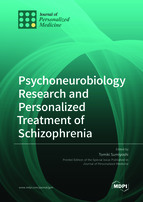Psychoneurobiology Research and Personalized Treatment of Schizophrenia
A special issue of Journal of Personalized Medicine (ISSN 2075-4426). This special issue belongs to the section "Mechanisms of Diseases".
Deadline for manuscript submissions: closed (30 June 2021) | Viewed by 29358
Special Issue Editor
Special Issue Information
Dear colleagues,
In an effort to develop effective treatments for unmet needs in schizophrenia, translational approaches—i.e., bridging preclinical and clinical studies—have been pursued, without noticeable success. To overcome the paucity of breakthrough therapeutics, novel paradigms from molecular biology, brain sciences, computational psychiatry and their combinations deserve consideration. In addition to psychotic symptoms, key areas of cognitive function—e.g., neurocognition, social cognition and metacognition—have attracted growing interest in an effort to improve social outcomes, or functionality, for patients. These endeavors should bear personalized or precision medicine in mind.
Besides the development of innovative compounds, there has been a trend towards non-pharmacological therapeutics, e.g., cognitive rehabilitation and neuromodulation (e.g., non-invasive brain stimulation) targeting schizophrenia. Further investigations into neurofeedback and environmental factors are also warranted. It is noteworthy that the effects of these treatment modalities have been related to biological markers provided by neurophysiological, neurochemical and structural/functional brain imaging methods.
This Special Issue will provide a forum for researchers interested in the phenomenology, underlying mechanisms and treatment of schizophrenia. Contributions will include, but not be limited to, papers dealing with genetic, molecular, imaging, physiological, psychological and behavioral issues. Overall, the information in this Special Issue will facilitate the development of personal therapeutics of greater clinical value.
Dr. Tomiki Sumiyoshi
Guest Editor
Manuscript Submission Information
Manuscripts should be submitted online at www.mdpi.com by registering and logging in to this website. Once you are registered, click here to go to the submission form. Manuscripts can be submitted until the deadline. All submissions that pass pre-check are peer-reviewed. Accepted papers will be published continuously in the journal (as soon as accepted) and will be listed together on the special issue website. Research articles, review articles as well as short communications are invited. For planned papers, a title and short abstract (about 100 words) can be sent to the Editorial Office for announcement on this website.
Submitted manuscripts should not have been published previously, nor be under consideration for publication elsewhere (except conference proceedings papers). All manuscripts are thoroughly refereed through a single-blind peer-review process. A guide for authors and other relevant information for submission of manuscripts is available on the Instructions for Authors page. Journal of Personalized Medicine is an international peer-reviewed open access monthly journal published by MDPI.
Please visit the Instructions for Authors page before submitting a manuscript. The Article Processing Charge (APC) for publication in this open access journal is 2600 CHF (Swiss Francs). Submitted papers should be well formatted and use good English. Authors may use MDPI's English editing service prior to publication or during author revisions.
Keywords
- molecular biology
- biomarkers
- precision medicine
- cognitive science
- neuropsychology
- cognitive enhancers
- neuromodulation
- neurofeedback
- environmental factors
- functionality







